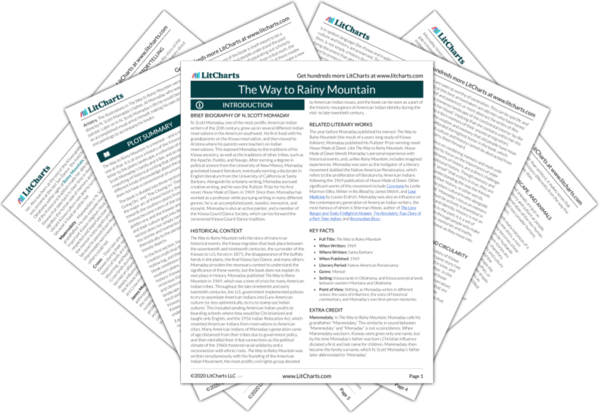Summary
Analysis
Momaday immediately introduces the arc of the story of the Kiowas, noting that their migration from the northern to the southern plains was one of adventure and triumph until tragedy struck and Kiowa culture withered. Momaday attributes this tragedy to the disappearance of the buffalo, since the buffalo (a key component of the Kiowa Sun Dance) were a pillar of Kiowa culture. Momaday notes that the tragedy that befell the Kiowas is ordinary in the scope of human history, and indicates that he prefers to focus on the time of the Kiowa migration when his people were at their most triumphant.
Momaday’s insistence on focusing on the Kiowa golden age rather than on Kiowa hardships and decline indicates the nature of the book: Momaday is attempting to preserve and promote Kiowa culture, rather than acknowledge and affirm the forces that have sought to destroy the Kiowas. This seems relevant to Momaday’s strange choice to emphasize the disappearance of the buffalo as the signifier of Kiowa decline instead of explicitly blaming the white settlers who killed all the buffalo and attempted to eradicate Kiowa culture. It’s not that Momaday is avoiding the subject—he has plenty to say about white violence later on—but in the opening he prefers to focus on the greatness of the Kiowas.
Themes
Momaday introduces Tai-me without explaining what Tai-me is—he writes simply that Tai-me came to the Kiowas in a time of suffering and made their lives better. The Kiowa journey with Tai-me was one of constant improvement; they moved to a warmer landscape, discovered horses, fulfilled their nomadic spirit, and built an alliance with the Comanches that allowed them to rule the southern plains for a hundred years.
This is the story of Kiowa greatness, the part of Kiowa history on which Momaday prefers to dwell. Momaday structures the story loosely around the three major periods of Kiowa history, and this passage describes the first two: the Kiowa journey out of the hardship of the northern plains, and the golden age in which the Kiowas ruled the southern plains. Notably, the story of Kiowa greatness is not limited to a focus on Kiowas; Momaday also gives credit to horses and the Comanches.
Themes
Stepping back, Momaday explains that the story of Kiowa migration is not only the history of the Kiowas, but also the history of an idea: the Kiowa’s idea of who they are as a people. He states that this idea exists, in its essence, in language, because the verbal tradition is all that remains of Kiowa history and culture. Since the Kiowa verbal tradition has weakened over time, though, this idea can only be communicated through fragments of myth and memory. Despite this, Momaday makes clear that Kiowa culture and spirit are still intact and vital.
Momaday explains that he is telling the history of the Kiowa migration in order to explain how the Kiowas understand themselves as a people. He also clarifies that this can only be comprehended through a careful examination of language, since language is all that exists of Kiowa history. Momaday clearly believes that language and stories not only speak about culture, but are themselves embodiments of culture. He also nods to the fragmentary nature of oral tradition, particularly an oral tradition as weakened as the Kiowas’. Because Kiowa history is transmitted through oral tradition, it requires a different, more fragmentary structure than traditional written Western history.
Themes
To explain his writing process and the importance of the book, Momaday suggests that the responsibility of the imagination is to tell an old story in a new way. For him, the Kiowa migration is a blend of history, legend, and personal and cultural memory—history and imagination, he insists, express reality in equally valid ways. He states that the three major components of this story are the landscape, a time that is long past, and the enduring spirit of the Kiowas. Momaday explains that he is interested in telling this story in a way that reflects the way the mind understands, remembers, and creates traditions. The journey to Rainy Mountain, he suggests, is at its core an expression of the identity and spirit of the Kiowas, one that should be understood as beautiful rather than tragic.
The idea that imagination and history are equally important to a person’s concept of reality is key to this book. Because the Kiowas understood history through an oral tradition of stories that mixed fact and myth, a simple retelling of the provable facts of Kiowa history might account for the passage of time, but would entirely exclude any notion of how the Kiowas understood their own relationship to the past, and even their values and culture in the present. Momaday is emphasizing again that the book should be understood as a cultural history rather than a literal, linear one. Its goal is to account for the identity and culture of the Kiowas, which Momaday insists is an optimistic project rather than a tragic one.
Themes
Get the entire Rainy Mountain LitChart as a printable PDF.













